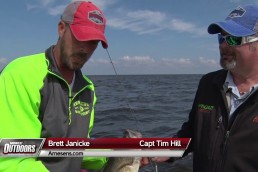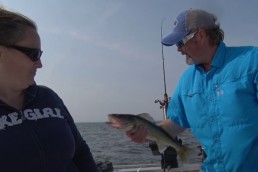Hooking Trophy Pike at Lake of the Woods
SHARE THIS POST
Tackling trophy pike at Lake of the Woods
Minnesota is gifted with lakes full of northern pike. When the discussion shifts to lakes with trophy pike (fish over 40 inches) the number of lakes to talk about drops off significantly. Known best for walleyes, Lake of the Woods is also home to big numbers of trophy pike—and late winter is a great time to catch them.
“The number of trophy pike in Lake of the Woods is very strong,” explains Tom Heinrich, Lake of the Woods Large Lake Specialist with the Minnesota DNR. Heinrich said some key components come together to create this big pike factory.
Genetic advantages
It is easier to keep good genetics in a lake than lose them and try and build them from scratch. When a pike makes it to 30 inches, this pike has beaten the odds of mortality and has a better chance to actually make it to the 40-inch-plus mark. It is a survivor, and has desirable genes it can pass on for years to come. Consequently, the current slot limit on Lake of the Woods pike is 30 to 40 inches. That means 30- to 40-inch pike must be released immediately. Anglers can keep three fish per day, with only one fish 40 inches or over. This, combined with the efforts of anglers to take a quick picture and release these big fish, helps sustain this trophy fishery.
Feed for the fat fish
Another component of a world-class pike fishery is ample forage. Lake of the Woods offers a variety of food to sustain large numbers of pike, plus a strong population of high-protein tulibees (aka ciscos) to grow ’em big.
“In the early 1990s, a DNR study showed the lakes that had big pike also had tulibees,” explains Heinrich. “When we do our test netting in the fall and get a big pike, there is a good chance there is a tulibee in its stomach. Also interesting, big pike typically do not have those black spots on them like the smaller pike do. The premise is, the smaller pike spend more time in shallower water around these intermediate parasites whereas larger pike feed on tulibees in deeper water.” In addition to tulibees, a large population of walleyes, saugers, perch, a variety of minnows and invertebrates help support multiple year classes of pike.
Spawning habitat
Big water with a variety of spawning habitat also builds trophy pike. Lake of the Woods offers a vast number of places to spawn, including rivers, tributaries, bays, and swampy areas. “Pike prefer to spawn on newly flooded vegetation rather than old, existing vegetation loaded with slippery algae,” says Heinrich. “The eggs stick better and pike love this habitat. This typically is in conjunction with a mud bottom.”
A variety of spawning areas around the lake help to level out the perils of spring storms, drastic fluctuations in the water levels as well as fluctuating water temps.
Key times to target big pike
The pike season on the Minnesota side of Lake of the Woods is open all year long. That means anglers can target them at key times pike congregate and have the feed bag on. Trophy pike are caught all year long, but, for most pike anglers, if there is one time period to consider, it’s March, and for good reason.
These trophy pike have a lot of water to roam. As the month of March approaches, the angle of the sun is different and the rays stronger. The days are longer, and water from melting ice infiltrates the system. These are all signs to the pike that it’s almost time to spawn. Pike not only put on the feed bag, they start to stage near spawning areas. Although pike are not a schooling fish, they do gather in the most viable spawning areas, making them vulnerable to tip-up anglers and creating memorable days with a lot of flags.
Where to target trophy pike
This is a complex question based on the time of year. Let’s focus on late February to ice out. The pike begin to move to the pre-spawn areas adjacent to areas where they will lay their eggs. Let’s get specific. On the south end of Lake of the Woods, we are talking about areas such as Four Mile Bay, Bostic Bay, Zippel Bay, Twin Islands, the shallow areas adjacent to spawning habitat around the Rocky Point area and the Swift Ditch area. The entire south shore has areas with sand and rubble transitions or mud that warm quickly and hold good pike, too.
Increase your odds by working through a resort or bait shop. You will get an idea of current ice conditions and directions to the areas inhabited by pike. Some resorts place fish houses in key pike areas with large windows to watch tip up flags. Some anglers enjoy this warm “home base” amidst the action.
Another area of Minnesota’s Lake of the Woods that holds a strong number of big pike is the NW Angle.
Are you enjoying this post?
You can be among the first to get the latest info on where to go, what to use and how to use it!
Unpressed pike
“Nobody really targets pike up here, it’s all walleyes,” says NW Angle ice guide Joe Cooper. “I really think the pike up here use rocky areas to feed just prior to the spawn. We target underwater rock points and sunken rock reefs with tip ups. Usually, dead ciscoes or dead suckers on a quick strike rig do the trick. Overall, we have great luck when we target pike. There are some monsters up here and they rarely get fished.”
Another great place to catch some fish is at Lake Mille Lacs.
Targeting big pike
The most common way to entice a monster pike to eat is to present an offering they regularly eat. Big bait rules. Whether it is a live sucker or a frozen cisco, big pike hunt for both.
The most common set up is a quick-strike rig. With two treble hooks coming off of leader material, your big baitfish can hang horizontally, one treble just behind the head and the other in front of the tail. Not only is this a nice presentation, the angler can set the hook quickly after the flag goes up. This increases the percentage of hook-ups and kills fewer fish as most pike don’t have time to swallow the hooks.
Another set-up gaining popularity uses circle hooks. With a circle hook, the angler doesn’t “set” the hook as with a quick-strike rig or traditional hook. Instead, the angler just pulls in line.The circle hook slides to the corner of the pike’s mouth and gets lodged.
Be prepared
These fish are absolute beasts. Use caution when battling a big pike of this magnitude. Be ready to let the fish run a couple of times before working it up the hole. Be prepared when that fish comes up. Equipment such as gloves, your camera, ruler or tape measure, long needle nose, jaw spreaders and a good pair hook cutters are key. Have equipment ready, things happen fast. If a hook gets caught deep, rather than ripping it out, cut it off with a hook cutter. Save the fish.
Like any big fish you intend to release, don’t hold the fish vertically as the sheer weight can tear organs and tissues. Instead, carefully grab the pike with one hand slid up inside the gill plate toward the hard membrane under its jaw and support the weight of the fish horizontally under its belly with the other hand. Do not grab the pike in the gills or by the eyes as this causes mortality. Take any pictures quickly and get the fish back into the water. If handled correctly, the fish will live to fight another day.
Success strategies
A number of techniques increase your odds of catching big pike. First off, live bait or dead bait? It depends upon the day. Some days, the fish home in on the live suckers, other days they seem to prefer the easy, stinky meal of dead bait. Try both.
Successful anglers use three strategies with tip-up depths. The first is 2 or 3 feet off of the bottom. This common set-up targets pike swimming along the bottom. With your bait up off of the bottom, pike easily see the offering and take action.
Another method is laying a dead bait right in the mud where big pike don’t hesitate to grab it. This presents a dead fish where pike are used to finding them. Some folks believe it works because pike often grab hibernating frogs from the shallow mud by grabbing a mouthful of mud and frog and shooting the mud through their gills. Regardless of how the pike see it, on certain days, this method rules.
A third technique is setting your bait right below the ice. Walleye anglers peering in holes often see big pike swimming just under the ice, possibly feeding on released fish. This technique should be considered in your initial spread. Once a few flags fly, you probably can recognize a pattern.
For many years most anglers thought that to catch a pike of a lifetime they had to travel hundreds of miles by plane far north of the border. With conscientious management, forward-thinking anglers, and a number of key environmental factors, Lake of the Woods has become the “go to” destination for monster pike.
MWO
SHARE THIS POST
Did you enjoy this post?
You can be among the first to get the latest info on where to go, what to use and how to use it!
Joe Henry
Tournament angler and licensed charter captain Joe Henry fishes and hunts the Midwest. Henry is a media member of AGLOW and writes for numerous publications, creates videos, appears on a variety of outdoor TV and radio shows and is a frequent seminar speaker. Henry is the Executive Director of Lake of the Woods Tourism.



